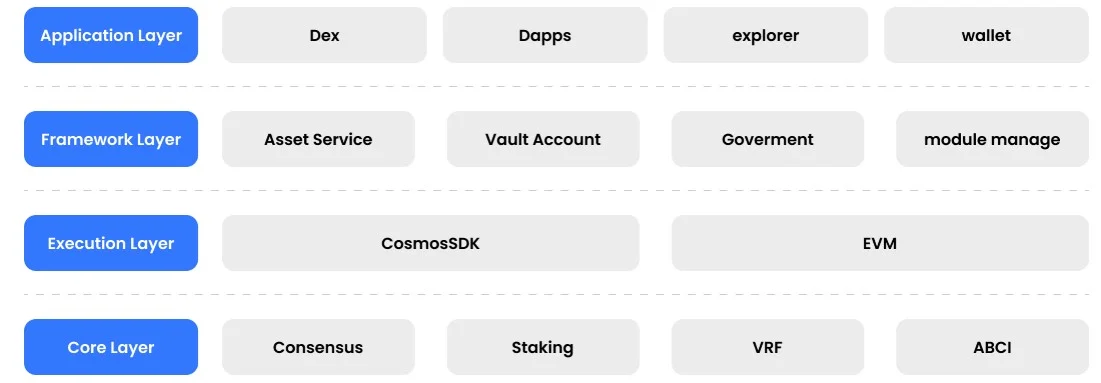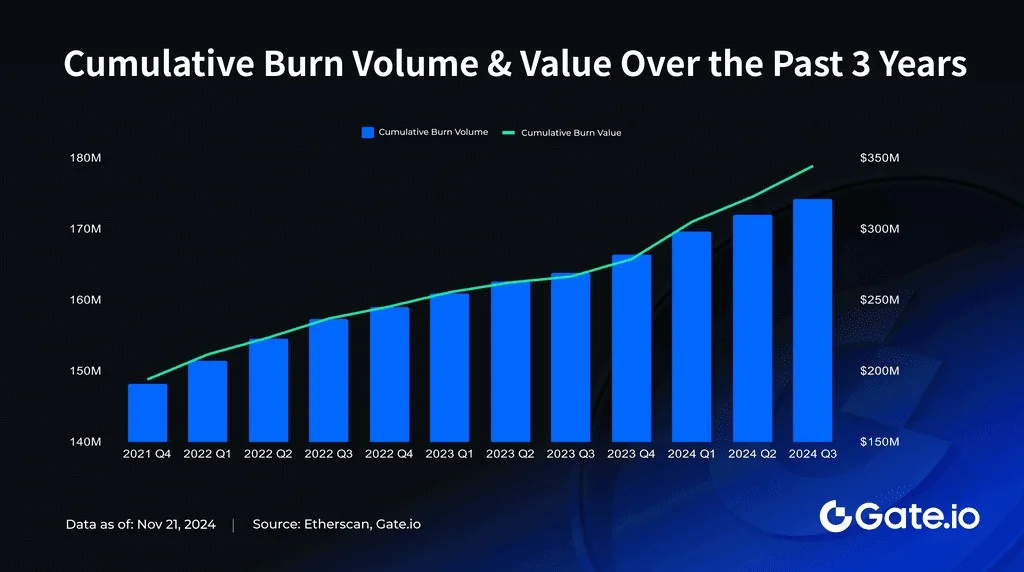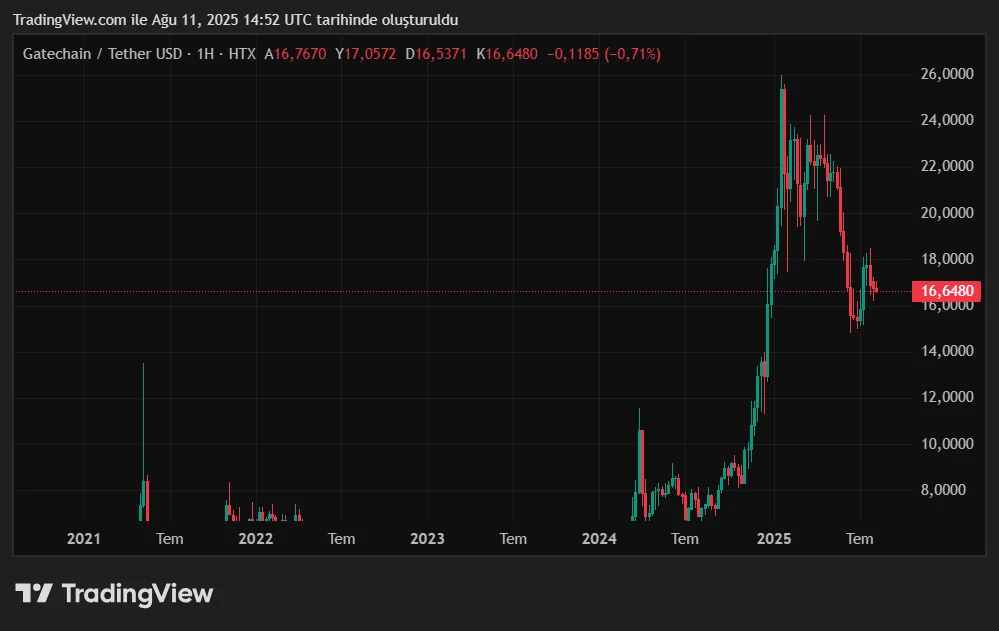In its early years, the cryptocurrency market was largely operated through simple exchanges that only allowed trading. Over time, as these exchanges grew, they began developing different solutions to further connect users to their ecosystems and increase trading volume. One of the most effective of these solutions was the issuance of platform tokens by exchanges. Platform tokens not only provided direct benefits to users, such as reduced transaction fees, but also made the exchanges' own ecosystems more sustainable. Following examples like Binance's BNB and OKX's OKB, Gate.io made a similar move.
GateToken (GT), a name we frequently hear in the cryptocurrency world, is also known as "Gate.io coin" or "GT coin." If you're wondering what GT coin is, what Gate.io coin is, and what it does, we can say that it's a versatile token that offers various advantages to users within the Gate.io ecosystem and operates as the native cryptocurrency of the GateChain blockchain network. Launched in 2019, GT was fully integrated with Gate.io's own network, GateChain, in 2020 and has since played a significant role in both the exchange and the blockchain. In this guide, we will examine what GT is, how it emerged, why it is valuable, and in what areas it is used.
Definition and Origins of GateToken
GateToken (GT) is the official platform token of the Gate.io exchange, launched to power its ecosystem. It was developed to provide Gate.io users with additional benefits and privileges. The GT token was first announced in April 2019 and launched immediately thereafter. At that time, Gate.io experimented with a different system called "Gate Points" to distribute GT. Users could purchase Gate Points at Gate.io's sale event and exchange them for GT tokens. At the end of this process, on April 21, 2019, the GT token was listed and traded on the exchange with GT/USDT and GT/BTC pairs. GT's technical infrastructure is based on the GateChain blockchain developed by Gate.io. The mainnet went live in 2020, and GT became the network's native cryptocurrency. This means that the GT token isn't just a utility token offering transaction fee discounts or platform advantages on Gate.io; it's also used as a governance and payment tool on GateChain. So, what is GateChain? GateChain, an Ethereum-compatible Layer-1 (EVM-compatible) platform, stands out with its fast transaction times, low fees, and security-focused architecture. GT tokens are used both to pay transaction fees and to contribute to network security through staking.

In short, GateToken was designed to provide Gate.io users with on-platform benefits and play a central role in Gate.io's blockchain project, GateChain. The GT token offers privileges such as exchange discounts, pre-sale opportunities, and voting, while also serving as GateChain's native asset, playing a crucial role in the blockchain infrastructure.
GateToken's History: Key Milestones
Since its launch in 2019, GateToken has been at the core of both the Gate.io platform and the GateChain blockchain. As cryptocurrency exchanges developed their own platform tokens, GT quickly attracted attention with the advantages it offers to Gate.io users. Over the years, significant developments have been made in both the technical infrastructure and its application areas; These included the launch of the GateChain mainnet, the launch of GT's staking and governance features, Launchpad events, and regular token burn programs. As the GateToken and Gate.io ecosystems grew together, GT strengthened its role within the exchange and became an integral part of the platform's long-term strategy. Below, you can find the most important milestones in the history of GT coin, chronologically.
- 2013: The Gate.io exchange (originally known as Bter) was founded. Founder Han Lin laid the foundation for a platform that prioritized user security and innovation.
- 2019: The GT token was announced and launched as the platform token. The first GT distribution was made through the Gate Points campaign in April 2019. GT coin was listed on the exchange on April 21, 2019.
- 2020: Gate.io launched the mainnet of its own blockchain, GateChain. In March 2020, GT officially became Gate.io's platform token and GateChain's native token. This began using GT as a means of paying transaction fees and staking on GateChain.
- 2022–2023: The GT token's use within the Gate.io ecosystem significantly increased. During these years, GT was heavily used in features such as Launchpad (Startup) sales, HODL & Earn programs, Lending services, and community votes. The importance of GT was reinforced by requiring GT holdings to participate in IEO/Startup events. GT holders contributed to governance by participating in votes on projects to be listed on Gate.io.
- 2024: The reduction of the GT token supply continued through a regular burn program. Since 2020, Gate.io has implemented a policy of buying back and burning GT from the markets with a portion of its profits. As of 2024, the circulating supply of GT coins has dropped to approximately 120 million. This year, GT's liquidity and usability have further increased with Gate.io's growing user base.
Why is GateToken Valuable?
The value of GT as an exchange token stems from both the advantages it provides on the Gate.io platform and its functionality on GateChain. What are the benefits of the GT token? Here are the key elements and uses that make GateToken valuable:
Trading Fee Discounts
One of the most well-known advantages of holding GT on Gate.io is the discount on trading fees. Depending on the amount of GT you hold, you pay progressively lower commissions on spot, futures, and margin transactions. For active traders, these discounts translate into significant savings over time. Moreover, it's not just about commission discounts; the amount of GT you hold also determines your VIP level on Gate.io. As your VIP level increases, your trading fees decrease, and additional platform privileges become available.
Launchpad and Early Access
The GT token is the key to early investment in new projects on Gate.io's Startup (Launchpad) platform. Participation generally requires a certain average balance of GT coins in your wallet. Users who meet this requirement can participate in pre-sale (IEO) events for new projects before others. In some events, GT holders can even earn free airdrops of listed coins or purchase them at a discounted price. Holding GT gives you the opportunity to invest in high-potential projects before they're listed on Gate.io.
HODL & Earn (passive income)
GateToken offers the opportunity to earn passive income through staking and various earning programs. In the HODL & Earn or Earn section of Gate.io, you can lock your GTs for a certain period and earn interest. On the GateChain side, users who stake using the Proof-of-Stake (PoS) mechanism are rewarded with block rewards for contributing to the security of the network. While returns may fluctuate periodically, Gate.io offers incentive programs, allowing long-term GT investors to earn additional income.
Lending and other financial services
Gate.io also offers Crypto Lending, where users lend their assets and earn interest. It's possible to use GT tokens in this area; You can lend GT and earn interest, or you can borrow various cryptocurrencies using GT as collateral. GT is also useful in Gate.io's Liquidity Mining and Launchpool sections. By providing liquidity, you can earn rewards from newly issued tokens, allowing you to passively invest your GT holdings.
Governance and Voting Rights
GT holders have a direct say in how the Gate.io ecosystem is shaped. GT is used in voting for newly listed coins, generally meaning 1 GT = 1 vote. Users vote for the projects they support by locking their GT and, in return, often receive airdrop rewards in the tokens of the projects they vote for. Similarly, GT acts as a governance token for network upgrades or technical changes affecting GateChain's future, with community members contributing to decisions by voting.
Deflationary Supply Model
GT's total supply is planned to decrease over time. Gate.io regularly conducts token burns to maintain and strengthen the value of its platform token. The first burn in 2019 marked a significant step; 700 million of the initial 1 billion supply were burned, bringing the total to 300 million. In subsequent years, a percentage of the profits were used to buy back and burn GT. For example, since September 2020, Gate.io has been buying and burning GT with 15% of its profits each quarter. By June 2022, over 151 million GT had been removed from circulation. By 2025, this number had decreased further, leaving approximately 120 million GT in circulation.


Increasing Use Cases and Liquidity
Gate.io's ever-growing user base and diverse range of services are constantly expanding the GT token's use cases. As new features and campaigns are introduced to the platform (e.g., Gate Pay integrations, NFT marketplace advantages, or DeFi applications on GateChain), GT is integrated into these areas, providing additional benefits. Furthermore, GT isn't limited to Gate.io; it's also traded on other major exchanges like Huobi and Bitfinex. This increases its liquidity and facilitates adoption by reaching a wider investor base.

In short, GateToken's value is determined both by its advantages at Gate.io and its significant role within GateChain. Owning a GT is like having a special membership card within the Gate.io ecosystem; you benefit from discounts and exclusive opportunities. Moreover, this card is one of the most critical components of the GateChain blockchain.
Who is the Founder of GateToken?
So, who is the GT coin? The GT token is backed by Dr. Han Lin, founder and CEO of Gate.io. Han Lin (also known as Lin Han in some sources), who founded Gate.io in 2013, is an early player in the crypto world and a strong advocate of blockchain technology. The GT token officially launched under his leadership in 2019.
While GT's technical development is led by Gate.io's engineering team, the project focuses on community participation. User feedback is considered in management and development decisions, and GT holders have direct input through their voting rights. Therefore, while Gate.io is the founding team, the true long-term owner of the project is seen as the community.
The GateChain blockchain is also being developed by the same team. Han Lin and his team built GateChain with innovative solutions focused on protecting user funds (e.g., the Vault Account system to prevent theft). The GT token, which runs on this robust infrastructure, is a project that perfectly reflects Gate.io's vision. Thanks to Han Lin's leadership, Gate.io and the GT token have established themselves as some of the most well-known platform tokens in the industry today.
Frequently Asked Questions (FAQ)
You may have many questions about GateToken. In this section, we've compiled concise and clear answers to the most frequently asked questions by users. You can find basic information here, from what GT does to the staking process.
- What is GateToken and what does it do?: GateToken is the platform token of the Gate.io exchange and a cryptocurrency that offers various advantages to its users. The GT token offers many functions, including transaction fee discounts, priority participation in Launchpad/Startup sales, staking for passive income, and payment of transaction fees on the GateChain network. In short, GT serves a dual role as both a reward/perk tool for the Gate.io ecosystem and the native currency of the GateChain blockchain.
- What network does the GT token operate on?: The GT token operates on its own blockchain, GateChain, developed by Gate.io. The GateChain network is a high-speed blockchain with an Ethereum-compatible (EVM) infrastructure, and GT is its native token. Additionally, GT was initially created as an ERC-20 token on Ethereum, but with the launch of GateChain, its primary use became the GateChain network.
- How to stake the GT token: There are several ways to stake the GT token. The first is to lock GTs in your account for a certain period and earn daily/monthly interest using products like HODL & Earn or GT Staking on the Gate.io exchange. The second method is to stake GT by becoming a validator on the GateChain network or delegating it to a validator. By locking your GT to contribute to network security through GateChain's Proof-of-Stake mechanism, you can earn additional GT by earning a share of block rewards and transaction fees. Staking operations on the platform are generally carried out through user-friendly interfaces, and you can unstake at any time.
- Is the GateToken supply limited, and how does the burn process work?: Yes, the GT token supply is limited and even decreases over time. The initial maximum supply was set at 300 million GT (1 billion were created in the initial issuance, and 700 million were burned immediately, reducing the actual supply to 300 million). Gate.io conducts regular token burns to maintain the value of GT. These burns typically involve Gate.io buying back GT from the market with a portion of its platform revenues and permanently removing these purchased tokens from circulation. For example, GT is bought back and burned with 15% of the profits earned each quarter, and this program has been ongoing since 2019. As a result, the circulating supply of GT is constantly decreasing (deflation), and this makes the remaining tokens scarcer, positively impacting the price in the long run.
- What advantages does GT offer Gate.io users?: Owning GT tokens offers Gate.io users many advantages. First, they pay lower commissions when trading thanks to reduced transaction fees. Users who hold a certain amount of GT can upgrade their VIP membership level on the exchange and benefit from various privileges, from withdrawal limits to enhanced customer service. GT also serves as a key to participating in Gate.io's Startup (Launchpad) events, granting priority access to new token sales and participating in free airdrops. Furthermore, GT holders can participate in voting for projects to be listed on Gate.io, thus contributing to their success. In addition, GT holders can participate in voting for projects to be listed on Gate.io, thus having a say in the platform's development. In short, GT functions like a combination of a discount coupon, membership card, voting rights, and a passive income tool for a user in the Gate.io ecosystem.
- What's the difference between GateChain and GT?: GateChain is the name of the blockchain network developed by Gate.io; GT is its native cryptocurrency. In other words, GateChain is the technological infrastructure on which smart contracts run and transactions occur (think of it like the Ethereum network). The GT token, like Ether (ETH) on the Ethereum network, is the digital asset used for transactions on GateChain, used to pay fees and manage the network. When transactions are made on the GateChain network, fees are paid in GT, network validators are rewarded in GT, and network security is ensured by staking GT. In short, GateChain is the platform itself, while GT is the fuel and means of transferring value.
Follow our JR Kripto Guide series for more information on exchange tokens, platform benefits, and on-chain governance solutions.